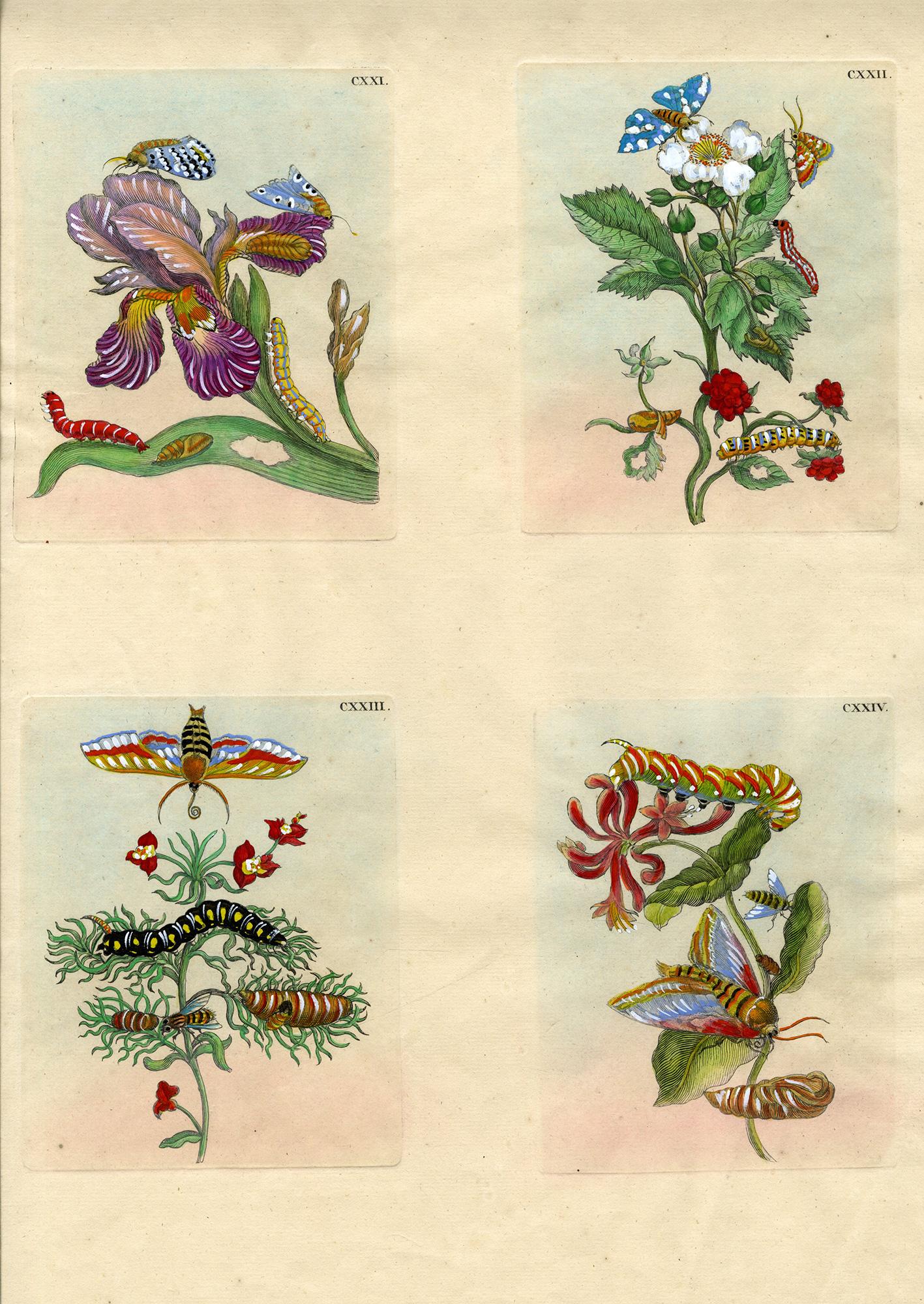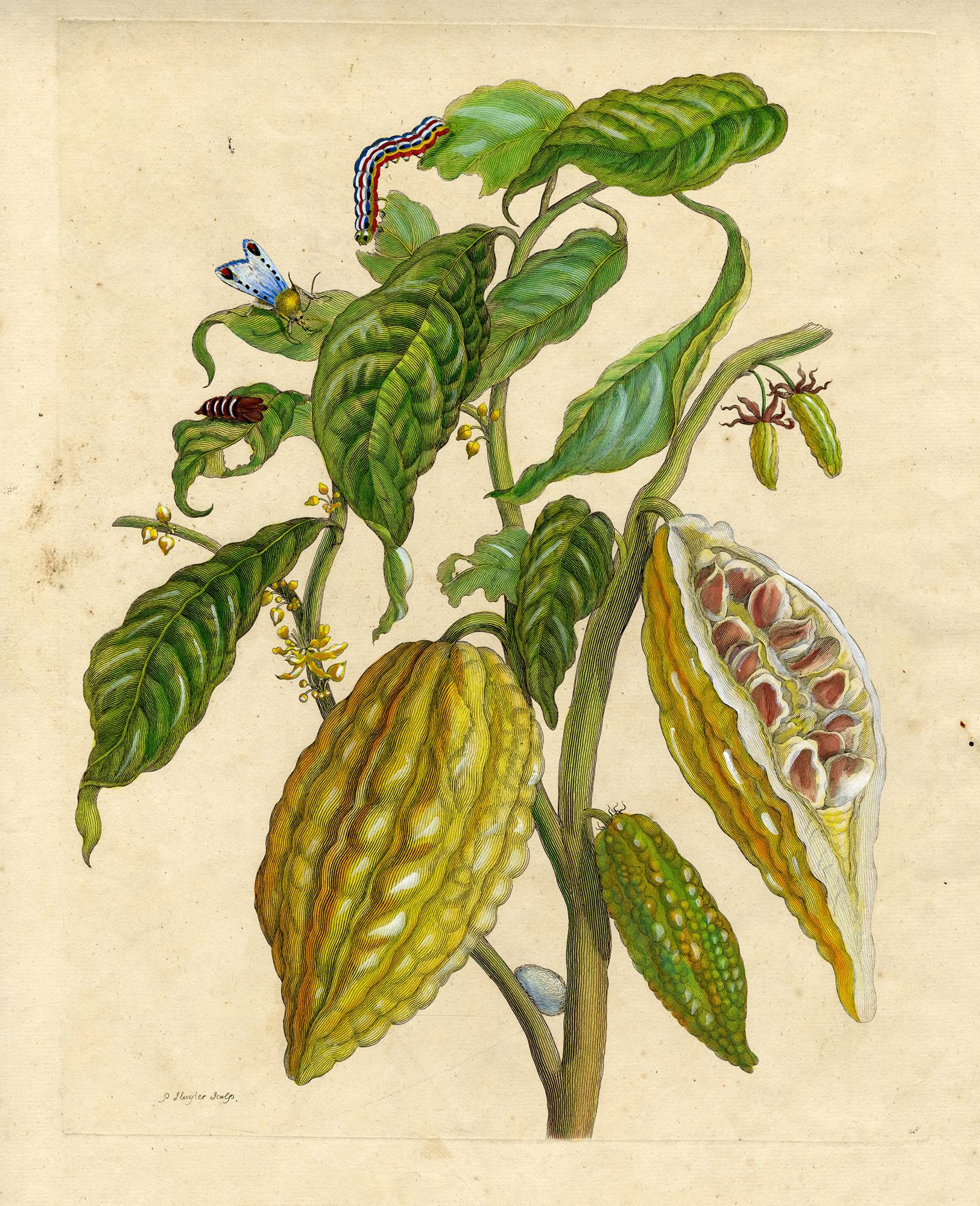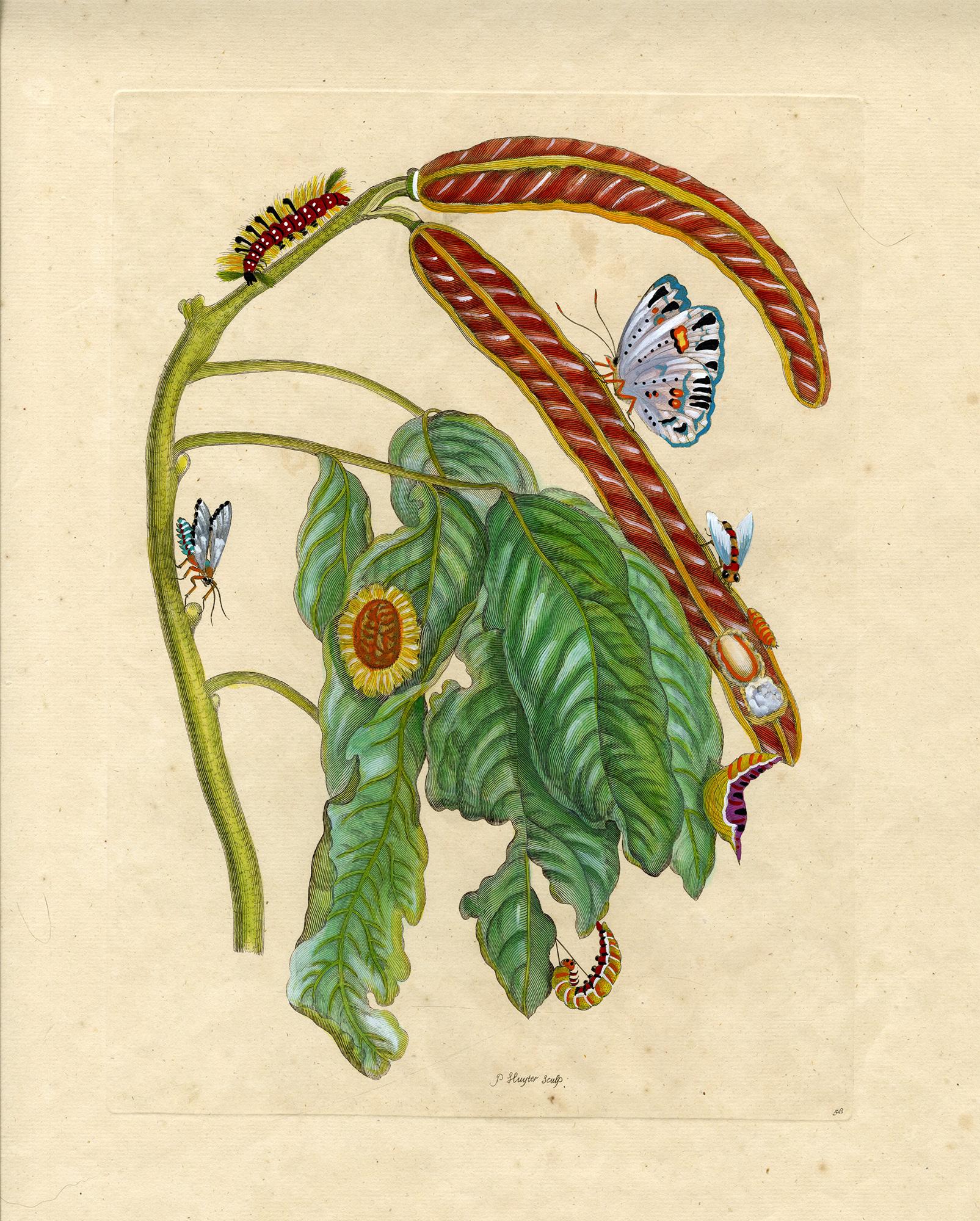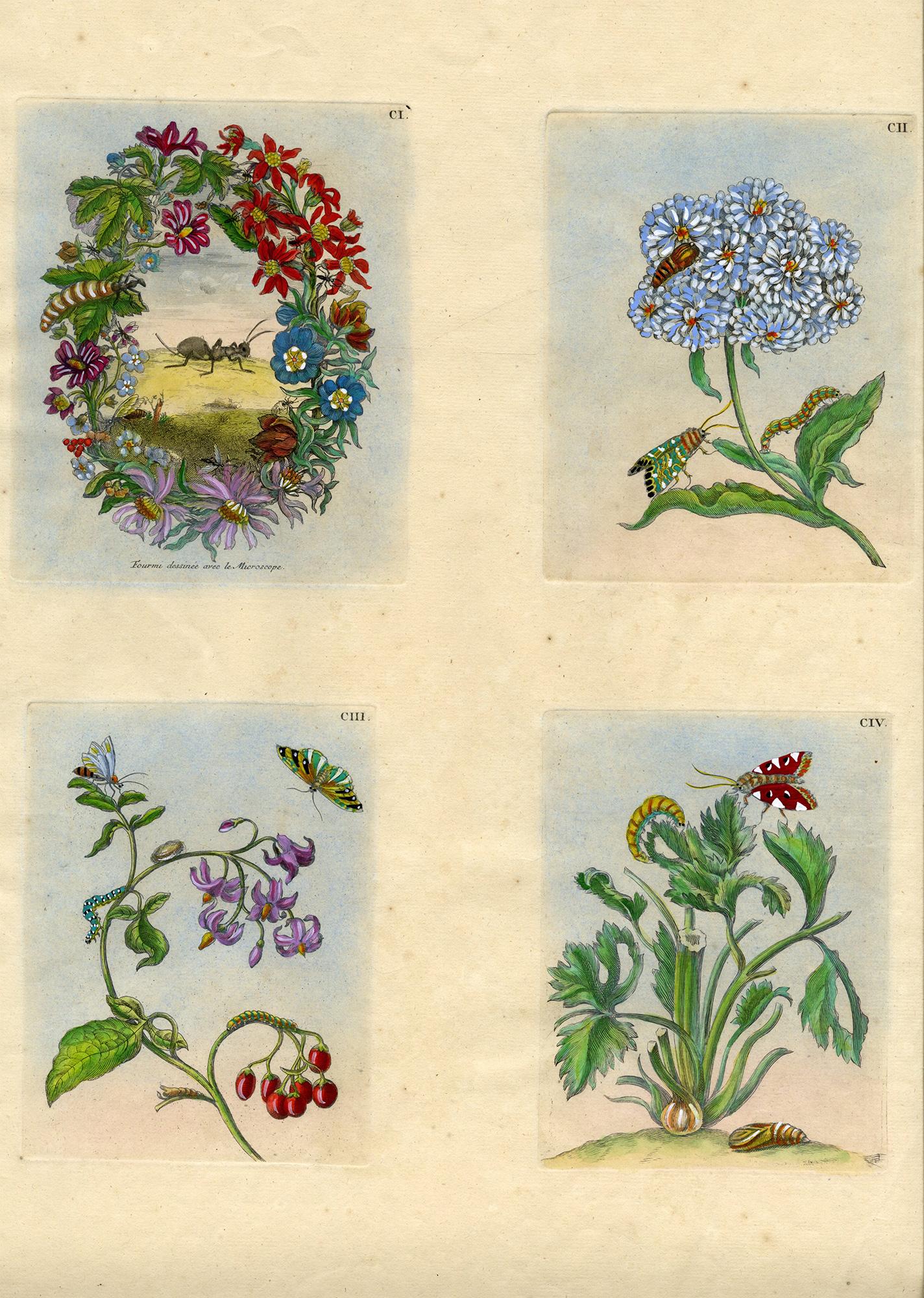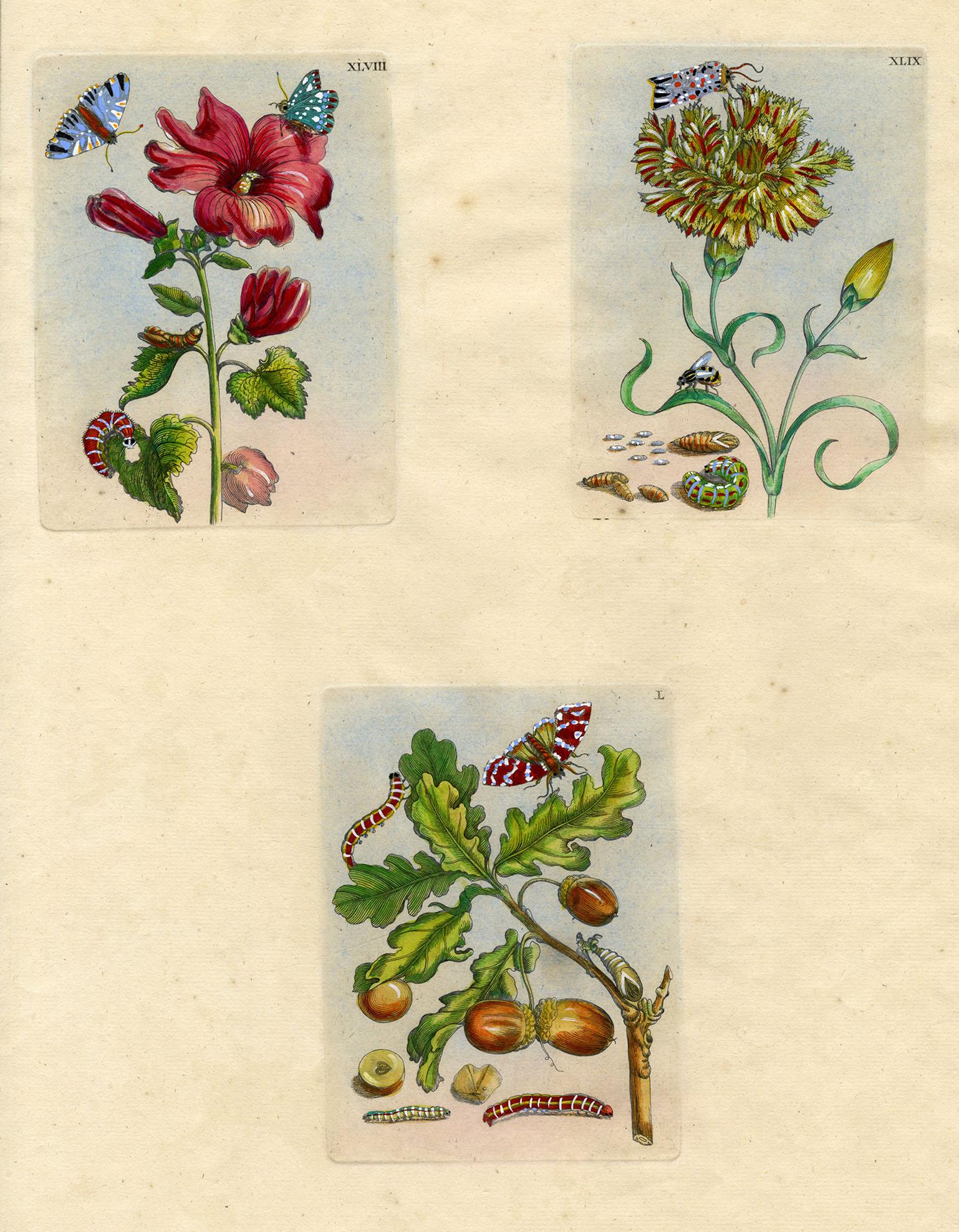Items Similar to 4 plates from The Wondrous Transformation of Caterpillars & their Strange Diet..
Want more images or videos?
Request additional images or videos from the seller
1 of 5
Maria Sibylla Merian4 plates from The Wondrous Transformation of Caterpillars & their Strange Diet..1730
1730
About the Item
Four plates from The Wondrous Transformation of Caterpillars and their Strange Diet of Flowers. “Wolfsmelk Rupsen;" “Wolfsmilch, Raupe und Schmetterling" Amsterdam: J F Bernard, 1730. Each an engraving with hand coloring in watercolor and gouache printed on one sheet of watermarked Honig cream laid paper, each measures 6 1/4 x 5 inches (157 x 121 mm), sheet measures 20 5/8 x 14 inches (522 x 355 mm), full margins. With handling creases in the lower right sheet quadrant, as well as minor, loose cockling, otherwise in very good condition. The colors are superb with exceptionally fresh and bright saturation. Engraved between 1679 and 1683, printed 1730. Plates included: LIV, LV, LVI, & LVII.
MARIA SIBYLLA MERIAN was one of the most highly respected entomologists of the 17th century, and remains today one of the field's most significant figures. A German-born naturalist and scientific illustrator, she reared herself on the study of caterpillars, and made tremendous contributions to the knowledge of the life cycles of numerous species. Until her detailed and careful study of the process of metamorphosis it was thought that insects were "born of mud," through spontaneous generation.
Trained as a miniature painter by her stepfather, she published her first book of illustrations in 1675, at the age of 28. In 1679, Merian published the first volume of the two-volume series on caterpillars, The Wondrous Transformation of Caterpillars and their Strange Diet of Flowers; the second volume followed in 1683. Each volume contained 50 plates that she engraved and etched. In 1699, Merian traveled to Dutch Guiana to study and record the tropical insects native to South America. The result was her 1705 magnum opus Metamorphosis Insectorum Surinamensium. Merian's Metamorphosis has been credited with heavily influencing the way naturalists presented their illustrations to include a life form in various stages of development.
Years after her death, Merian has been honored by having a number of taxa and three genera named after her. According to Jennifer Pomeroy's 2018 biography, three butterflies have been named after Merian; in 1905 a form of a split-banded owlet butterfly Opsiphanes cassina merianae; in 1967 a subspecies of the common postman butterfly Heliconius melpomene meriana; and in 2018 a rare butterfly Catasticta sibyllae from Panamá. In addition, the Cuban sphinx moth has been named Erinnyis merianae, a Tessaratomidae bug has been named Plisthenes merianae, a genus of mantises has been named Sibylla, the orchid bee Eulaema meriana, and the bird-eating spider Avicularia merianae was named in her honor, referencing her research on spiders. The spider Metellina merianae was named after her in 2017. An Argentine tegu lizard has been named Salvator merianae. A toad was named Rhinella merianae. A snail was named Coquandiella meriana. The Madagascan population of the African stonechat bird was given the name Saxicola torquatus sibilla. A genus of flowering plants was named Meriania, and an iris-like plant was given the name Watsonia meriana. [Sarah B. Pomeroy; Jeyaraney Kathirithamby (2018). Maria Sibylla Merian: Artist, Scientist, Adventurer. Getty Publications.]
NOTES ON THE WATERMARK:
"Watermarks representing the arms of Strasbourg, a bend on a •shield surmounted by a large fleur-de-lys, are characteristic of 'Royal Paper'; paper of the largest standard size and always of high quality. In various forms, the 'Strasbourg Lily' occurs in Angoumois, Dutch and English papers in the later seventeenth and eighteenth centuries. The `WR' monogram at the bottom of the mark probably originated as the personal sign of Wendelin Riehel, a printer who rented a paper mill in Strasbourg during the sixteenth century; it was later widely used as a neat but meaningless termination to the pendant centre-line of many heraldic watermarks." [Viola a da Gamba Society, Appendix I: Watermarks and Paper Types, 268-272]
The design of the Strasbourg Lily was used by the Honig papermakers between 1741 and 1822. The lettering "C & I HONIG" occurs between 1730 and 1869. It is known that the brothers Cornelis Jacobszoon and Jan Jacobszoon Honig worked together under the name "C & I Honig" but started new companies, each one for himself, in 1738. Cornelis (1683-1755) continued under the name "C & I Honig," now together with his son Jacob Cornelisz Honig (1707-1770). [Klepikov, S. A., Some information over the "Honig" watermarks, IPH Information. Bulletin of the International Association of Paper Historians (IPH), N.S., vol. 6, no. 1 (January 1972), 10-13.]
- Creator:Maria Sibylla Merian (1647 - 1717, Dutch)
- Creation Year:1730
- Dimensions:Height: 20.63 in (52.41 cm)Width: 14 in (35.56 cm)
- Medium:
- Movement & Style:
- Period:
- Condition:
- Gallery Location:Middletown, NY
- Reference Number:
About the Seller
5.0
Vetted Seller
These experienced sellers undergo a comprehensive evaluation by our team of in-house experts.
Established in 2004
1stDibs seller since 2022
29 sales on 1stDibs
Typical response time: 12 hours
- ShippingRetrieving quote...Ships From: Middletown, NY
- Return PolicyA return for this item may be initiated within 30 days of delivery.
More From This SellerView All
- 4 plates from The Wondrous Transformation of Caterpillars & their Strange Diet..By Maria Sibylla MerianLocated in Middletown, NYFour plates from The Wondrous Transformation of Caterpillars and their Strange Diet of Flowers. “Wolfsmelk Rupsen;" “Wolfsmilch, Raupe und Schmetterling" Amsterdam: J F Bernard, 1730. Each an engraving with hand coloring in watercolor and gouache printed on one sheet of watermarked Honig cream laid paper, each measures 6 1/4 x 5 inches (157 x 121 mm), sheet measures 20 5/8 x 14 inches (522 x 355 mm), full margins. With one 1.5 inch inch tear across the area of the top-left corner, well outside of image area. Handling creases in the lower right sheet quadrant, as well as minor, loose cockling, otherwise in very good condition. The colors are superb with exceptionally fresh and bright saturation. Engraved between 1679 and 1683, printed 1730. Plates included: CXXI, CXXII, CXXIII, & CXXIV. MARIA SIBYLLA MERIAN was one of the most highly respected entomologists of the 17th century, and remains today one of the field's most significant figures. A German-born naturalist and scientific illustrator, she reared herself on the study of caterpillars, and made tremendous contributions to the knowledge of the life cycles of numerous species. Until her detailed and careful study of the process of metamorphosis it was thought that insects were "born of mud," through spontaneous generation. Trained as a miniature painter by her stepfather, she published her first book of illustrations in 1675, at the age of 28. In 1679, Merian published the first volume of the two-volume series on caterpillars, The Wondrous Transformation of Caterpillars and their Strange Diet of Flowers; the second volume followed in 1683. Each volume contained 50 plates that she engraved and etched. In 1699, Merian traveled to Dutch Guiana...Category
Early 18th Century Naturalistic Still-life Prints
MaterialsWatercolor, Engraving
- Cocoa plant, caterpillar, ..., Plate 26, Metamorphosis Insectorum SurinamensiumBy Maria Sibylla MerianLocated in Middletown, NYMetamorphosis Insectorum Surinamensium, Plate No. 26; Cocoa plant, caterpillar, pupa, and butterflies. The Netherlands: 1705. En...Category
Early 18th Century Naturalistic Still-life Prints
MaterialsWatercolor, Engraving
- Icecream Bean plant..., plate no. 58, Metamorphosis Insectorum SurinamensiumBy Maria Sibylla MerianLocated in Middletown, NYMetamorphosis Insectorum Surinamensium, Plate No. 58; Ice Cream Bean Plant, Cloudless Sulphur Butterfly and Caterpillar with Mot...Category
Early 18th Century Naturalistic Still-life Prints
MaterialsWatercolor, Engraving
- 4 plates from The Wondrous Transformation of Caterpillars & their Strange Diet..By Maria Sibylla MerianLocated in Middletown, NYFour plates from The Wondrous Transformation of Caterpillars and their Strange Diet of Flowers. “Wolfsmelk Rupsen;" “Wolfsmilch, Raupe und Schmetterling" Amsterdam: J F Bernard, 1730. Each an engraving with hand coloring in watercolor and gouache printed on one sheet of watermarked Honig cream laid paper, each measures 6 1/4 x 5 inches (157 x 121 mm), sheet measures 20 5/8 x 14 inches (522 x 355 mm), full margins. With handling creases in the lower right sheet quadrant, as well as minor, loose cockling, otherwise in very good condition. The colors are superb with exceptionally fresh and bright saturation. Engraved between 1679 and 1683, printed 1730. Plates included: CI; CII; CIII & CIV. MARIA SIBYLLA MERIAN was one of the most highly respected entomologists of the 17th century, and remains today one of the field's most significant figures. A German-born naturalist and scientific illustrator, she reared herself on the study of caterpillars, and made tremendous contributions to the knowledge of the life cycles of numerous species. Until her detailed and careful study of the process of metamorphosis it was thought that insects were "born of mud," through spontaneous generation. Trained as a miniature painter by her stepfather, she published her first book of illustrations in 1675, at the age of 28. In 1679, Merian published the first volume of the two-volume series on caterpillars, The Wondrous Transformation of Caterpillars and their Strange Diet of Flowers; the second volume followed in 1683. Each volume contained 50 plates that she engraved and etched. In 1699, Merian traveled to Dutch Guiana...Category
Early 18th Century Naturalistic Still-life Prints
MaterialsWatercolor, Engraving
- 4 plates from The Wondrous Transformation of Caterpillars & their Strange Diet..By Maria Sibylla MerianLocated in Middletown, NYFour plates from The Wondrous Transformation of Caterpillars and their Strange Diet of Flowers. “Wolfsmelk Rupsen;" “Wolfsmilch, Raupe und Schmetterling" Amsterdam: JF Bernard, 1730. Each an engraving with hand coloring in watercolor and gouache printed on one sheet of watermarked Honig cream laid paper, each measures 6 1/4 x 5 inches (157 x 121 mm), sheet measures 20 5/8 x 14 inches (522 x 355 mm), full margins. With handling creases in the lower right sheet quadrant, as well as minor, loose cockling, otherwise in very good condition. The colors are superb with exceptionally fresh and bright saturation. Engraved between 1679 and 1683, printed 1730. Plates included: CXLI, CXLII, CXIII & CXLIV. MARIA SIBYLLA MERIAN was one of the most highly respected entomologists of the 17th century, and remains today one of the field's most significant figures. A German-born naturalist and scientific illustrator, she reared herself on the study of caterpillars, and made tremendous contributions to the knowledge of the life cycles of numerous species. Until her detailed and careful study of the process of metamorphosis it was thought that insects were "born of mud," through spontaneous generation. Trained as a miniature painter by her stepfather, she published her first book of illustrations in 1675, at the age of 28. In 1679, Merian published the first volume of the two-volume series on caterpillars, The Wondrous Transformation of Caterpillars and their Strange Diet of Flowers; the second volume followed in 1683. Each volume contained 50 plates that she engraved and etched. In 1699, Merian traveled to Dutch Guiana...Category
Early 18th Century Naturalistic Still-life Prints
MaterialsWatercolor, Engraving
- Tree with moth, caterpillar..., Plate 39, Metamorphosis Insectorum SurinamensiumBy Maria Sibylla MerianLocated in Middletown, NYMetamorphosis Insectorum Surinamensium, Plate No. 39; Unidentified tree with moth, caterpillar and pupa. The Netherlands: 1705....Category
Early 18th Century Naturalistic Still-life Prints
MaterialsWatercolor, Engraving
You May Also Like
- Green Painted Sea Shell Lithograph Edition 33 of 34By Frances NailLocated in Houston, TXGreen shell lithograph of a cone shell. Print is edition 33 of 34. Signed and dated by the artist along with titled. Print is framed in a golden frame...Category
1970s Naturalistic Still-life Prints
MaterialsLithograph
- Kate Boxer, I Won't Eat You, Limited edition animal print, contemporary artLocated in Deddington, GBI Won’t Eat You [2021] limited_edition Drypoint print Edition number of 30 Image size: H:81 cm x W:113 cm Complete Size of Unframed Work: H:92 cm x W:122 cm x D:0.1cm Sold Unframed ...Category
21st Century and Contemporary Contemporary Animal Prints
MaterialsDrypoint, Etching, Paper
- "The Winner" - Etching on Paper (10/25)Located in Soquel, CA"The Winner" - Etching on Paper Clean and modern drypoint etching of a horse skeleton by Maria Bennett (American, 20th Century). This etching has layer...Category
1970s Modern Still-life Prints
MaterialsPaper, Ink, Drypoint
- Colombe (Dove of Peace returns to ark with olive branch in her beak)By Mario AvatiLocated in New Orleans, LA"And the dove came in to him in the evening; and, lo, in her mouth was a plucked off olive leaf: so Noah knew that the waters were abated from off the earth." Mario Avati, a master ...Category
Late 20th Century Contemporary Animal Prints
MaterialsMezzotint
- Violin et Coquille (violin and shell / inscribed Happy New Year 2000)By Laurent SchkolnykLocated in New Orleans, LAThis black and white mezzotint of a shell next to a violin is an artist proof that was inscribed Happy New Year 2000 and signed by the artist. The regular e...Category
1990s American Modern Still-life Prints
MaterialsMezzotint
- Snow Does (Doe, a deer - a female deer)By Carol WaxLocated in New Orleans, LAAn exclusive publication for Stone and Press Gallery, "Snow Does" was created in an edition of 100. It is FIROS #66 in the catalogue raisonne. Carol Wax originally trained to be a c...Category
1990s American Modern Still-life Prints
MaterialsMezzotint
Recently Viewed
View AllMore Ways To Browse
Antique Names
Antique Plates From Germany
I Antique On Line
From Plant To Plate
Monogrammed Antique Plates
20 Century Large Plate
Population Of Antique
Antique Moth
Lily Plate
Antique Cycle
Antique Cycling
Cycle Antique
Royal Lily
18th C American Art
African American Artist Still Life
Antique Miniature Plates
Antique Quadrant
Lv Rare
